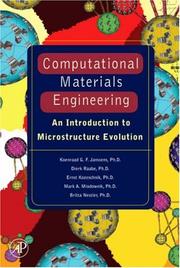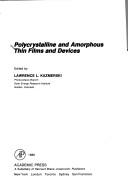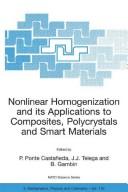| Listing 1 - 9 of 9 |
Sort by
|
Book
ISBN: 9535161113 9533079347 Year: 2012 Publisher: IntechOpen
Abstract | Keywords | Export | Availability | Bookmark
 Loading...
Loading...Choose an application
- Reference Manager
- EndNote
- RefWorks (Direct export to RefWorks)
The book "Polycrystalline Materials - Theoretical and Practical Aspects" is focused on contemporary investigations of plastic deformation, strength and grain-scale approaches, methods of synthesis, structurals, properties, and application of some polycrystalline materials. It is intended for students, post-graduate students, and scientists in the field of polycrystalline materials.
Polycrystals. --- Polycrystalline solids --- Polycrystalline substances --- Crystals --- Crystallography

ISBN: 1281186597 9786611186593 0080555497 012369468X 9780123694683 9780080555492 9781281186591 661118659X Year: 2007 Publisher: Amsterdam Boston Elsevier / Academic Press
Abstract | Keywords | Export | Availability | Bookmark
 Loading...
Loading...Choose an application
- Reference Manager
- EndNote
- RefWorks (Direct export to RefWorks)
Computational Materials Engineering is an advanced introduction to the computer-aided modeling of essential material properties and behavior, including the physical, thermal and chemical parameters, as well as the mathematical tools used to perform simulations. Its emphasis will be on crystalline materials, which includes all metals. The basis of Computational Materials Engineering allows scientists and engineers to create virtual simulations of material behavior and properties, to better understand how a particular material works and performs and then use that knowledge to design improvements
Crystals --- Microstructure --- Polycrystals --- Mathematical models. --- Polycrystalline solids --- Polycrystalline substances --- Materials --- Matter --- Morphology --- Micromechanics --- Stereology --- Crystallography, Mathematical --- Constitution
Book
ISBN: 019507744X Year: 1993 Publisher: New York (N.Y.) : Oxford university press,
Abstract | Keywords | Export | Availability | Bookmark
 Loading...
Loading...Choose an application
- Reference Manager
- EndNote
- RefWorks (Direct export to RefWorks)
Crystals --- Plasticity --- Polycrystals --- #KVIV:BB --- Polycrystalline solids --- Polycrystalline substances --- Cohesion --- Deformations (Mechanics) --- Elasticity --- Plastics --- Rheology --- Crystallography --- Powders --- Solids --- Crystals. --- Plasticity. --- Polycrystals.
Book
ISBN: 1536108189 9781536108187 9781536107968 Year: 2017 Publisher: York
Abstract | Keywords | Export | Availability | Bookmark
 Loading...
Loading...Choose an application
- Reference Manager
- EndNote
- RefWorks (Direct export to RefWorks)
Thin films. --- Polycrystals. --- Polycrystalline semiconductors. --- Amorphous semiconductors --- Semiconductors --- Polycrystalline solids --- Polycrystalline substances --- Crystals --- Films, Thin --- Solid film --- Solid state electronics --- Solids --- Surfaces (Technology) --- Coatings --- Thick films
Book
ISBN: 0128190779 0128190639 9780128190777 9780128190630 Year: 2021 Publisher: Duxford, England : Woodhead Publishing,
Abstract | Keywords | Export | Availability | Bookmark
 Loading...
Loading...Choose an application
- Reference Manager
- EndNote
- RefWorks (Direct export to RefWorks)
Grain boundaries. --- Polycrystals --- Superplasticity. --- Plastic properties. --- Metals --- Plasticity --- Polycrystalline solids --- Polycrystalline substances --- Crystals --- Crystal grain boundaries --- Crystal growth --- Dislocations in crystals --- Twinning (Crystallography) --- Ductility
Book
ISBN: 303813371X 9783038133711 9783908451785 3908451787 Year: 2010 Publisher: Stafa-Zurich Trans Tech
Abstract | Keywords | Export | Availability | Bookmark
 Loading...
Loading...Choose an application
- Reference Manager
- EndNote
- RefWorks (Direct export to RefWorks)
The great majority of solid-state materials - natural as well as man-made ones - have a polycrystalline structure. They consist of crystallites having various sizes, shapes and crystallographic orientations. Because of the anisotropy of crystal properties, the material as a whole may also be anisotropic if the orientation distribution of the crystallites is not random. Furthermore, because of the differently oriented anisotropies of neighbouring crystals, the material is also micro-inhomogeneous. Macroscopic anisotropy and micro-inhomogeneity are thus fundamental properties of all polycrystall
Polycrystals --- Texture (Crystallography) --- Anisotropy --- Crystal texture --- Crystalline texture --- Crystals --- Crystallography --- Polycrystalline solids --- Polycrystalline substances --- Texture --- 548.5 --- 548.5 Formation, growth and solution of crystals --- Formation, growth and solution of crystals --- Conferences - Meetings --- ITAP

ISBN: 0124038808 0323156045 1299481965 9780124038806 Year: 1980 Publisher: New York: Academic press,
Abstract | Keywords | Export | Availability | Bookmark
 Loading...
Loading...Choose an application
- Reference Manager
- EndNote
- RefWorks (Direct export to RefWorks)
Solid state physics --- Thin films --- Thin film devices --- Polycrystals --- Semiconductor films --- Optoelectronic devices --- Optical films --- Protective coatings --- 538.9 --- Polycrystalline solids --- Polycrystalline substances --- Crystals --- Photo electric devices --- Photo electronic devices --- Photoelectronic devices --- Electronic apparatus and appliances --- Optical instruments --- Electrooptical devices --- Integrated optics --- Films, Thin --- Solid film --- Solid state electronics --- Solids --- Surfaces (Technology) --- Coatings --- Thick films --- Devices, Thin film --- Films, Semiconductor --- Semiconductors --- Coating compositions --- Corrosion and anti-corrosives --- Films, Optical --- Optical materials --- Physics of condensed matter (in liquid state and solid state) --- 538.9 Physics of condensed matter (in liquid state and solid state) --- Photonic devices --- Photonic instruments
Book
ISBN: 9400767986 9400767994 9401781400 Year: 2014 Volume: 44 Publisher: Dordrecht : Springer Science,
Abstract | Keywords | Export | Availability | Bookmark
 Loading...
Loading...Choose an application
- Reference Manager
- EndNote
- RefWorks (Direct export to RefWorks)
Polycrystalline SiGe has emerged as a promising MEMS (Microelectromechanical Systems) structural material since it provides the desired mechanical properties at lower temperatures compared to poly-Si, allowing the direct post-processing on top of CMOS. This CMOS-MEMS monolithic integration can lead to more compact MEMS with improved performance. The potential of poly-SiGe for MEMS above-aluminum-backend CMOS integration has already been demonstrated. However, aggressive interconnect scaling has led to the replacement of the traditional aluminum metallization by copper (Cu) metallization, due to its lower resistivity and improved reliability. Poly-SiGe for MEMS-above-CMOS sensors demonstrates the compatibility of poly-SiGe with post-processing above the advanced CMOS technology nodes through the successful fabrication of an integrated poly-SiGe piezoresistive pressure sensor, directly fabricated above 0.13 m Cu-backend CMOS. Furthermore, this book presents the first detailed investigation on the influence of deposition conditions, germanium content and doping concentration on the electrical and piezoresistive properties of boron-doped poly-SiGe. The development of a CMOS-compatible process flow, with special attention to the sealing method, is also described. Piezoresistive pressure sensors with different areas and piezoresistor designs were fabricated and tested. Together with the piezoresistive pressure sensors, also functional capacitive pressure sensors were successfully fabricated on the same wafer, proving the versatility of poly-SiGe for MEMS sensor applications. Finally, a detailed analysis of the MEMS processing impact on the underlying CMOS circuit is also presented.
Engineering --- Systems engineering --- Optical materials --- Surfaces (Physics) --- Physics --- Electrical & Computer Engineering --- Engineering & Applied Sciences --- Electrical Engineering --- Microelectromechanical systems. --- Metal oxide semiconductors, Complementary. --- Polycrystals. --- Polycrystalline solids --- Polycrystalline substances --- CMOS (Electronics) --- Complementary metal oxide semiconductors --- Semiconductors, Complementary metal oxide --- MEMS (Microelectromechanical systems) --- Micro-electro-mechanical systems --- Micro-machinery --- Microelectromechanical devices --- Micromachinery --- Micromachines --- Micromechanical devices --- Micromechanical systems --- Physics. --- Electronic circuits. --- Nanotechnology. --- Optical materials. --- Electronic materials. --- Materials science. --- Electronic Circuits and Devices. --- Circuits and Systems. --- Optical and Electronic Materials. --- Nanotechnology and Microengineering. --- Characterization and Evaluation of Materials. --- Material science --- Physical sciences --- Electronic materials --- Optics --- Materials --- Molecular technology --- Nanoscale technology --- High technology --- Electron-tube circuits --- Electric circuits --- Electron tubes --- Electronics --- Natural philosophy --- Philosophy, Natural --- Dynamics --- Crystals --- Digital electronics --- Logic circuits --- Transistor-transistor logic circuits --- Electromechanical devices --- Microtechnology --- Mechatronics --- Systems engineering. --- Engineering. --- Surfaces (Physics). --- Surface chemistry --- Surfaces (Technology) --- Construction --- Industrial arts --- Technology --- Engineering systems --- System engineering --- Industrial engineering --- System analysis --- Design and construction


ISBN: 1402026218 9786610190614 1280190612 1402026234 9400789246 1402026226 Year: 2004 Volume: 170 Publisher: Dordrecht ; Boston ; London Brussels Kluwer Academic Publishers NATO Scientific Affairs Division
Abstract | Keywords | Export | Availability | Bookmark
 Loading...
Loading...Choose an application
- Reference Manager
- EndNote
- RefWorks (Direct export to RefWorks)
Although several books and conference proceedings have already appeared dealing with either the mathematical aspects or applications of homogenization theory, there seems to be no comprehensive volume dealing with both aspects. The present volume is meant to fill this gap, at least partially, and deals with recent developments in nonlinear homogenization emphasizing applications of current interest. It contains thirteen key lectures presented at the NATO Advanced Workshop on Nonlinear Homogenization and Its Applications to Composites, Polycrystals and Smart Materials. The list of thirty one contributed papers is also appended. The key lectures cover both fundamental, mathematical aspects of homogenization, including nonconvex and stochastic problems, as well as several applications in micromechanics, thin films, smart materials, and structural and topology optimization. One lecture deals with a topic important for nanomaterials: the passage from discrete to continuum problems by using nonlinear homogenization methods. Some papers reveal the role of parameterized or Young measures in description of microstructures and in optimal design. Other papers deal with recently developed methods – both analytical and computational – for estimating the effective behavior and field fluctuations in composites and polycrystals with nonlinear constitutive behavior. All in all, the volume offers a cross-section of current activity in nonlinear homogenization including a broad range of physical and engineering applications. The careful reader will be able to identify challenging open problems in this still evolving field. For instance, there is the need to improve bounding techniques for nonconvex problems, as well as for solving geometrically nonlinear optimum shape-design problems, using relaxation and homogenization methods.
Homogenization (Differential equations) - Materials. --- Homogenization (Differential equations) --- Mathematics --- Engineering & Applied Sciences --- Physical Sciences & Mathematics --- Engineering - General --- Calculus --- Materials --- Polycrystals --- Composite materials --- Smart materials --- Polycrystalline solids --- Polycrystalline substances --- Homogénéisation (Equations différentielles) --- Polycristaux --- Matériaux intelligents --- Homogénéisation (Equations différentielles) --- Matériaux intelligents --- EPUB-LIV-FT LIVMATHE Nonlinear Polycrystals SPRINGER-B homogenization --- Crystals --- Differential equations, Partial --- Composites --- Congresses. --- Congrès --- Engineering. --- Engineering mathematics. --- Mechanics. --- Mechanics, Applied. --- Engineering, general. --- Mathematical and Computational Engineering. --- Solid Mechanics. --- Classical mechanics --- Newtonian mechanics --- Physics --- Dynamics --- Quantum theory --- Applied mechanics --- Engineering, Mechanical --- Engineering mathematics --- Engineering --- Engineering analysis --- Mathematical analysis --- Construction --- Industrial arts --- Technology --- Applied mathematics. --- Solids. --- Technology and Engineering. --- Mathematical and Computational Engineering Applications. --- Data processing. --- Solid state physics --- Transparent solids
| Listing 1 - 9 of 9 |
Sort by
|

 Search
Search Feedback
Feedback About UniCat
About UniCat  Help
Help News
News